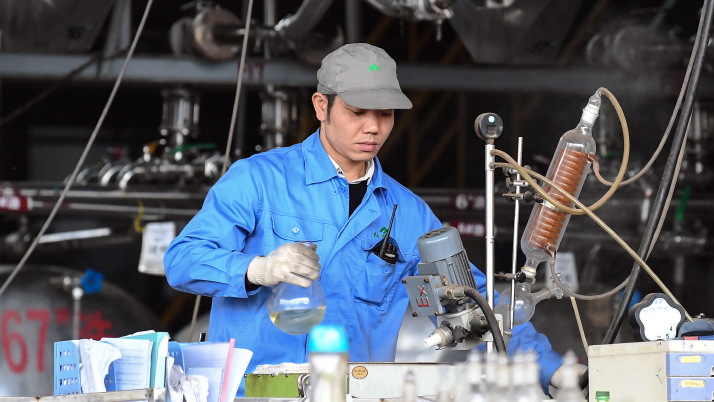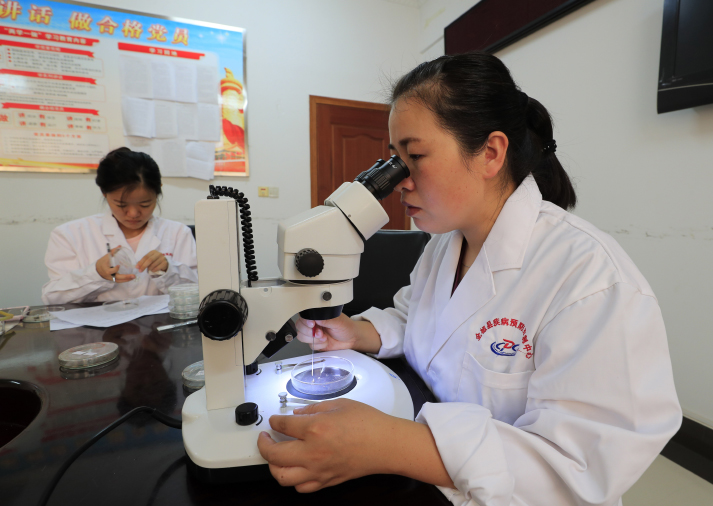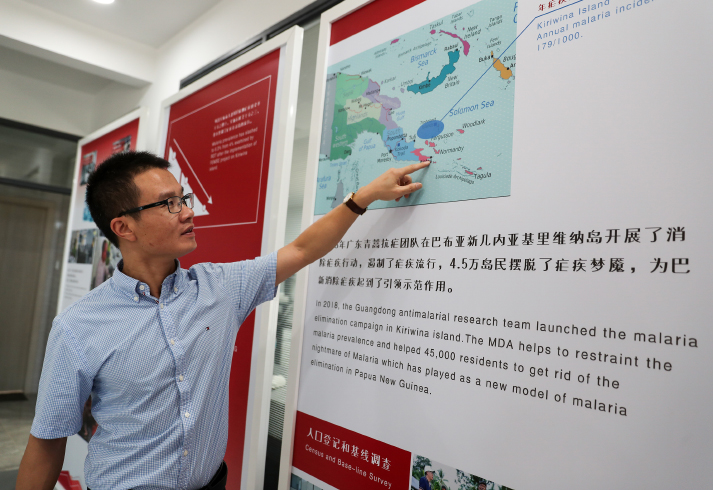| China |
| China has been declared malaria-free by the World Health Organization | |
|
|
 A worker produces artemisinin, a core compound in anti-malarial drugs, at a pharmaceutical company in Nanning, Guangxi Zhuang Autonomous Region, on April 27, 2019(XINHUA)
Dong Xueshu, an 86-year-old researcher with the Yunnan Institute of Parasitic Diseases in Yunnan Province, has been studying mosquitoes for seven decades. Dong's research started in 1956, when a malaria epidemic broke out in Menghai, a county in Xishuangbanna Dai Autonomous Prefecture, Yunnan. As there was no effective medicine for treating the disease at that time, Dong, who then worked for the Yunnan provincial epidemic prevention department, and his colleagues were tasked with finding the cause of the disease to stop its transmission. Although the Anopheles mosquitoes were already known to be the transmission medium, there were over 50 varieties of Anopheles mosquitoes in Menghai alone. Finding the specific mosquito types responsible for spreading the disease thus became a matter of the utmost urgency. Dong and his colleagues trapped mosquitoes in the bedrooms of local villagers and outside the pigsties and cowsheds. He had even used his own bare legs to entice the zooming little vampires. He would suck the insects into a tube and then determine whether they contained Plasmodium, the parasite causing malaria.  A staff member of the disease prevention and control center in Quanjiao, a county in Anhui Province, studies a mosquito specimen under a microscope on August 18, 2017. The center has been monitoring the Anopheles mosquitoes regularly from June to October every year in order to control the insect population as part of malaria prevention regulations (XINHUA)
After two years, Dong was able to identify the Anopheles minimus as the main medium for the transmission of malaria in the county. Through targeted mosquito prevention and eradication, the area's infection rate gradually came down. Yunnan used to be seriously affected by malaria as its rainy season, especially, offers fertile breeding grounds for mosquitoes. The province further borders three countries where malaria was prevalent, namely Laos, Myanmar and Viet Nam, with cross-border transmission leading to the spread of the disease. Through generations' efforts, Yunnan's malaria prevention and control have made big strides forward. The province realized its malaria-free goal in June after having reported zero indigenous cases for four consecutive years. Yunnan's progress epitomizes the country's achievements in its battle against malaria. On June 20, China was awarded a malaria-free certification by the World Health Organization (WHO), a remarkable feat for a country which reported around 30 million cases of the disease annually in the 1940s. Globally, 40 countries and territories have been granted the malaria-free certification by the WHO—including, most recently, El Salvador (2021), Algeria (2019), Argentina (2019), Paraguay (2018) and Uzbekistan (2018). The WHO grants the certification when a country has demonstrated that the chain of indigenous malaria transmission by Anopheles mosquitoes has been interrupted nationwide for the past three consecutive years at least. A country must also demonstrate its capacity to prevent the re-establishment of transmission, according the WHO website. "Congratulations to China on eliminating malaria," said Takeshi Kasai, Regional Director of WHO Western Pacific Regional Office. "China's tireless effort to achieve this important milestone demonstrates how strong political commitment and strengthening national health systems can result in eliminating a disease that once was a major public health problem. China's achievement takes us one step closer towards the vision of a malaria-free Western Pacific Region."  Deng Changsheng, a member of the Guangdong anti-malarial research team, introduces the malaria elimination campaign in Kiriwina, Papua New Guinea, on November 10, 2018. China has dispatched medical teams to the country to help locals fight the disease (XINHUA)
Combined efforts Tang Linhua, former head of the Shanghai-based National Institute for Parasitic Diseases (NIPD) of the Chinese Center for Disease Control and Prevention, was born in Shanghai in 1949, at a time when malaria was common in the city. Tang suffered from tertian ague, a form of malaria characterized by a fever that recurs every other day, when he was 7. The experience made him determined to work for the prevention and control of the disease. In 1978, Tang was admitted to Harbin Medical University to study public health and in 1983 he started working for the NIPD. At that time, there were still 3 million malaria cases annually in China. Tang recalled that during his first month of working at the institute, his task was to study mosquitoes. In 1988, Tang and two other colleagues traveled to the Huanghuai Plain, a plain which covers parts of Shandong, Henan, Anhui and Jiangsu provinces, to study why there were still malaria cases in the region. After their initial epidemiological investigation across four counties of the plain, the team discovered the relationship between the malaria cases and six particular factors, including the propagation of the Anopheles mosquitoes, the only known carrier of malaria. Their research went on to provide guidance for the joint prevention and control of malaria in the plain's five provinces. In addition to the endeavors of individual researchers like Dong and Tang, China's health authorities have worked non-stop to curb the spread of malaria since the 1950s by providing preventive anti-malaria medicine to those people at risk of contracting the disease and providing treatment to those already diagnosed with the illness. In 1956, the Central Government listed malaria as one of the five parasitic diseases that should be eliminated within a set period of time in its National Agricultural Development Plan for 1956-67. In 1964, China formulated a malaria prevention and treatment plan, emphasizing the use of systematic and scientific methods to control the infectious disease. However, owing to natural disasters, social turbulences and financial difficulties, the funding for prevention and treatment was deficient, resulting in a recurrence of the malaria epidemic. In the early 1960s and early 1970s, there were two outbreaks of malaria epidemic, respectively in north China and the middle reaches of the Yangtze River, with over 27 million cases reported. Tang said one hard lesson learned from the disaster was that without sustainable and science-guided prevention and control measures, the disease could and would recur, even if temporarily brought under control. In 1967, the Chinese Government launched the 523 Project with the aim of finding a new treatment for malaria. Over 500 scientists from 60 institutions participated. The project eventually led to the discovery of artemisinin, an ancient Chinese herbal therapy that could help counter malarial fevers, in the 1970s. Derived from the qinghao, or sweet wormwood plant, artemisinin and several of its derivatives became the core compound in the most effective and widely used anti-malaria drugs. In 2015, pharmaceutical chemist Tu Youyou was awarded the Nobel Prize in Physiology or Medicine for her contributions to the breakthrough. In the 1980s, China widely promoted the use of insecticide-treated mosquito nets to prevent malaria, well before the WHO recommended the use of such nets. Their usage led to significant reductions in malaria incidences in the areas where they were employed. By the end of 1990, the annual number of cases in China had been reduced to 117,000. In 2007, only 12,000 cases were reported, representing an incidence rate of less than 1 in 10,000. In 2007, the health authorities included malaria into the category of major infectious diseases which can be treated free of charge. Multi-sector collaboration, too, proved key to success. In 2010, 13 ministries including the National Development and Reform Commission, the Ministry of Education and the Ministry of Finance published the National Malaria Eliminating Action Plan (2010-20), which set the goal of eliminating malaria all across China, except for the border areas in Yunnan, by 2015 and eliminating the disease by 2020. The action plan put forward a 1-3-7 strategy. The "1" signifies the one-day deadline for medical institutions to report a malaria diagnosis; by the end of day three, health authorities are required to complete epidemiological survey, confirm if there are other cases and determine the risk of spread; and within seven days, appropriate measures, such as mosquito eradication, must be taken to prevent further spread of the disease. Sharing experiences The goal of eliminating malaria has been achieved. However, WHO Representative to Yunnan Gauden Galea said in an opinion piece published by China Global Television Network on June 30 that "countries like China that have been certified malaria-free must remain vigilant to prevent a return of the disease." He cited Yunnan as an example, reiterating that the province borders three malaria-endemic countries. "People travel in and out of Yunnan from these countries constantly and, as a result, the province reports about 300 imported cases of malaria each year." He also suggested China share its experiences in malaria prevention and control to contribute to the global fight against the disease. Zhou Xiaonong, head of the NIPD, said the Global Fund to Fight AIDS, Tuberculosis and Malaria, an international financial institution headquartered in Geneva, Switzerland, spends around $1.4 billion on the purchase of anti-malaria materials such as medicine, test kits, insecticide-treated nets and insecticides every year. "China has also provided some materials, such as artemisinin and mosquito nets. However, compared with the fund, the portion of materials provided by China is still small. We should continue to provide our technologies, products and talent to contribute to the elimination of malaria globally," Zhou said. Around 90 percent of the annual global malaria cases and deaths are spread across Sub-Saharan Africa. Zhou suggested that as China has eliminated malaria, half of the young people working in malaria prevention and control should take their efforts to Africa. "If they work in Africa for two to three years, their prevention and treatment abilities will improve." (Print Edition Title: Wiping Out an Infectious Disease) Copyedited by Elsbeth Van Paridon Comments to jijing@bjreview.com |
|
||||||||||||||||||||||||||||||
|
